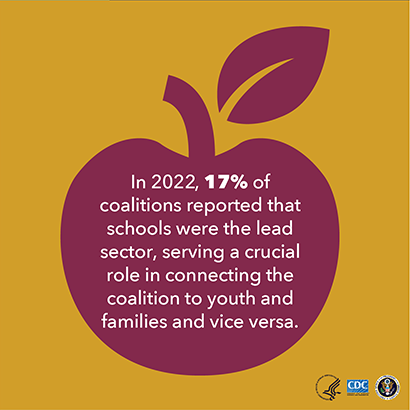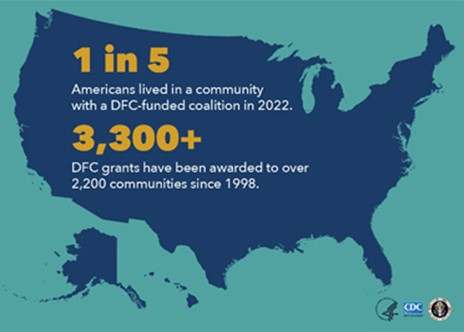
Most youth in the United States are in good health. Some, however, are at increased risk for behaviors that can lead to poor health, like substance use. Most adults who meet the criteria for having a substance use disorder started using substances during their teen and young adult years.
One way we can help reduce the chances of youth engaging in substance use is by changing aspects of their environment. This can look like increasing the number and quality of activities available for youth to participate in after school, training parents and teachers on the best ways to support young people or by promoting changes in the community that make substances more difficult to access. This is exactly what the Drug Free Communities (DFC) Support Program helps communities do.
The DFC Program is managed by the Centers for Disease Control and Prevention (CDC), with funding from the White House Office of National Drug Control Policy (ONDCP) and its focus is to prevent and reduce youth (aged 12-18) substance use while addressing issues like youth mental health.
The DFC Program funds communities to create coalitions—community groups that have representation from different community sectors that make a formal agreement to work together toward the common goal of preventing youth substance use. The sectors that coalitions are required to include are:
- Youth
- Parents
- Business
- Media
- School
- Youth-serving organizations
- Law enforcement
- Religious or fraternal organizations
- Civic or volunteer groups
- Healthcare professional organizations
- State, local, and tribal government agencies
- Other local organizations involved in reducing substance use.

Local Problems, Local Solutions: More than 750 community coalitions across the country receive funding up to $125,000 per year to strengthen collaboration among local partners and create an infrastructure that reduces youth substance use.
Picture this: You are 14 years old and your school, parents, doctor’s office, soccer coach, social media, peers, a sign at the bus stop, and a billboard, are all promoting the same messages to prevent youth substance use. Chances are you will be more likely to retain the information that you see. Combined with alternative options for spending your time like drug-free social events, parents and teachers that are trained to communicate with you about substance use and mental health issues and a community that helps to control the access and availability of substances for youth – this can create conditions that support you in making the decision to avoid engaging in substance use.
Here are a few real-world examples of things that DFC coalitions have accomplished:
- Drug Free Communities of Dallas County (DFCDC) in Alabama is addressing substance use among youth by delivering a message of hope through media and strategic communication in their community.
- Several coalitions in Cecil County, Maryland worked together to develop an education program for children with an incarcerated parent to help them increase self-esteem, develop healthy attitudes, and improve knowledge of essential life skills.
If you’re interested in learning more about what it’s like being part of a DFC coalition, CDC has compiled a list of ALL funded coalitions so you can look up the existing ones in your state and either partner with existing coalitions or learn about what they are doing and how to apply for funding so you might offer similar services in your own part of the state.
Already know you want to apply? Applications for the DFC Program are open now and are being accepted through April 17th, 2024. Check the eligibility requirements and apply here.
We look forward to engaging with you!
Karen Voetsch (she/her) is the Branch Chief of the Drug-Free Communities Branch
Centers for Disease Control and Prevention
Additional Resources:

